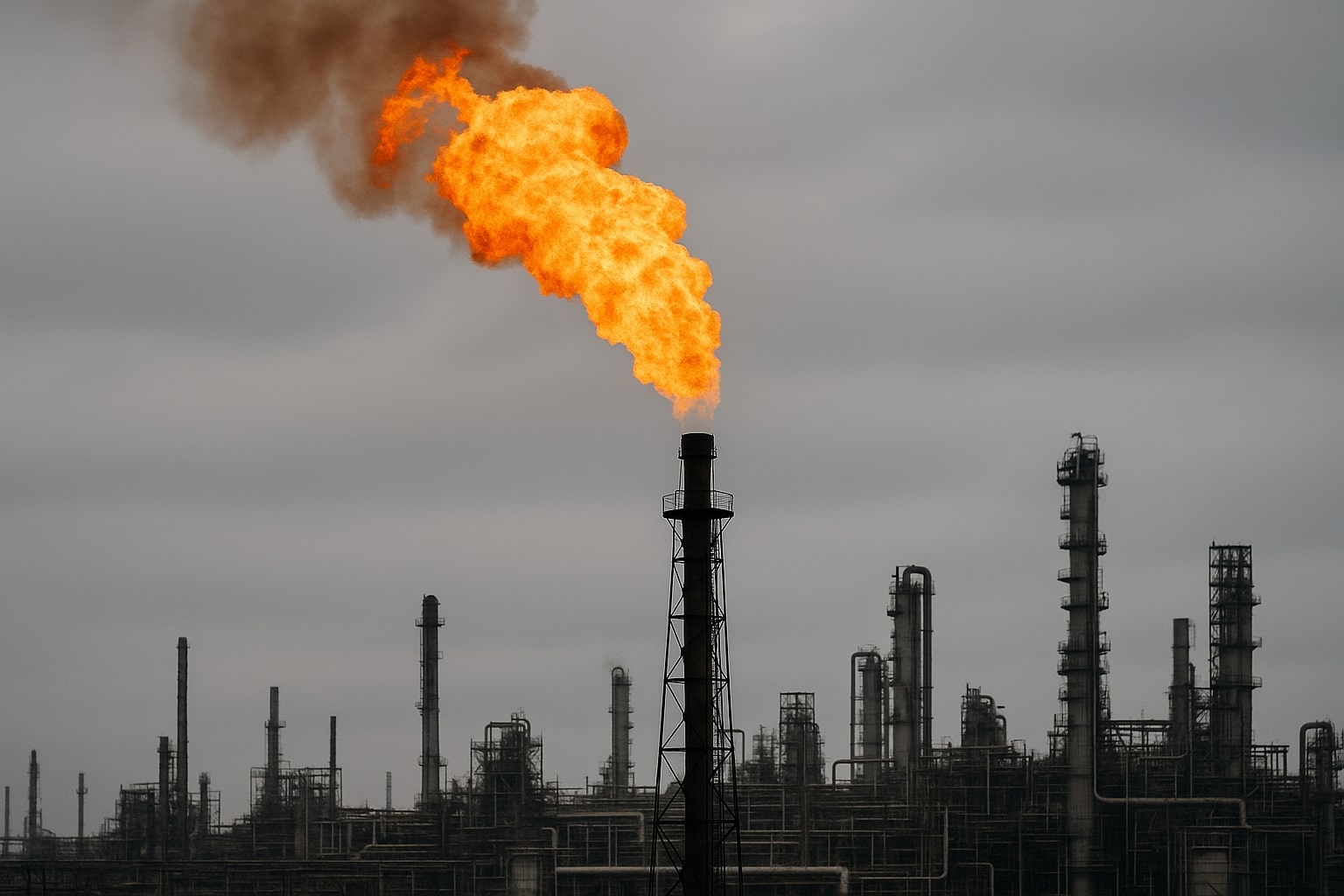
Oil Price Forecast - Oil Drops, WTI at $62.53 and Brent at $67 as Supply Surge from Iraq and OPEC+ Pressures Oil Markets
Crude retreats after EIA confirms record U.S. output, Iraq revives 160K bpd Kurdish exports, and China triples disguised Iranian imports; OPEC+ prepares further hikes while geopolitical risks from Houthi strikes, Crimea rationing, and Trump’s push on Russian sanctions keep volatility elevated | That's TradingNEWS
Crude Oil (CL=F) Slips to $62.53 as Supply Surge Collides With Geopolitical Risk Premium
Oil markets entered the final days of September under heavy selling pressure, with WTI (CL=F) settling near $62.53 per barrel, down 1.45% on the day, while Brent (BZ=F) traded around $67. The sharp retreat reflects a tug-of-war between swelling supply—driven by OPEC+ output increases, Iraq’s Kirkuk-Ceyhan restart, and record U.S. production—and persistent geopolitical risks in the Middle East and Russia. Despite recent weakness, the downside has been partly cushioned by ongoing attacks on energy infrastructure and heightened tensions across key supply routes.
EIA Data Confirms Record U.S. Output as Shale Resilience Defies Cuts
The latest EIA revisions show U.S. oil production reaching new record highs, outpacing prior forecasts. With Lower-48 output averaging more than 107.4 billion cubic feet per day of associated natural gas, crude flows have surged back into the global market. The resilience of U.S. shale comes despite capital discipline and workforce reductions—ExxonMobil (NYSE:XOM) announced layoffs of 2,000 employees, or 3% of its global staff, as part of a restructuring following its Pioneer Natural Resources acquisition. The combination of higher efficiency, technological upgrades, and investor demands for cash returns means the U.S. continues to pump aggressively even while rig counts only edge higher modestly.
OPEC+ Prepares New Hike With Capacity Questions Lingering
OPEC+ ministers meet next week with expectations centered on another 137,000 bpd increase in November quotas. This follows the decision to unwind 1.65 million bpd of collective cuts earlier than planned. Analysts note, however, that only about half of that pledged increase is likely to translate into real barrels, given structural overproduction and limited spare capacity among members. Brent futures, which were forecast by Wall Street banks to average $63.56 in Q4, have slipped below that level as traders factor in Iraq’s restart and Iranian/Venezuelan rerouted barrels reaching Asia. Goldman Sachs and Morgan Stanley warn that additional monthly hikes could keep Brent pinned near $63–65, while WTI averages $60–61 through early 2026.
Iraq’s Pipeline Restart and Kurdish Flows Add to Market Pressure
After more than two years offline, the Kirkuk-Ceyhan pipeline resumed operations, sending 150,000–160,000 bpd of Kurdish crude toward the Mediterranean. The restart adds another layer of supply pressure at a time when inventories are already near seasonal highs. For context, the added volumes represent more than 10% of the planned OPEC+ monthly hike. Baghdad’s ability to sustain flows will be closely monitored, as disruptions from political disputes previously shuttered the route. Combined with higher Venezuelan shipments to China—reported at 700,000 bpd, an all-time high—the market is adjusting to a sudden flood of non-core supply hitting spot channels.
Read More
-
VOO ETF Hits $630 as Fed Shift and AI Growth Power 2026 Rally Toward $700
07.12.2025 · TradingNEWS ArchiveStocks
-
XRP ETFs XRPI & XRPR Aim for $1B Inflows as XRP Holds $2.02 Support
07.12.2025 · TradingNEWS ArchiveCrypto
-
Natural Gas Price (NG=F) Rallies to $5.29, Freezing Temperatures Spark Bullish Breakout
07.12.2025 · TradingNEWS ArchiveCommodities
-
USD/JPY Price Forecast - Dollar Extends Slide to 154 as BoJ Hawkish Pivot Drive Yen Toward 150
07.12.2025 · TradingNEWS ArchiveForex
China’s Import Strategy Shifts as Iranian Tankers Rebrand Routes
Chinese customs data revealed imports of 2.7 million tonnes of “Indonesian” crude in August, triple July’s volume. In reality, much of this oil is believed to be Iranian, reclassified via ship-to-ship transfers near Batam Island. With Malaysia tightening regulations under U.S. pressure, Iran has shifted its rerouting hub, sustaining export levels despite sanctions. Meanwhile, Beijing’s record intake of Venezuelan barrels underscores its strategy to diversify suppliers and leverage discounted crude. The redirection of sanctioned flows effectively blunts Western efforts to curtail Iranian and Venezuelan output, keeping global balances looser than projected.
Geopolitical Flashpoints: Houthis, Crimea, and Sanctions Unrest
While fundamentals lean bearish, risk premia remain elevated. Houthi rebels in Yemen resumed drone strikes after a five-week pause, damaging a Dutch-flagged cargo ship in the Gulf of Aden. In Crimea, fuel rationing capped purchases at 30 liters per vehicle after Ukraine’s drone attacks on nearby refineries cut supplies. The U.N. also reinstated sanctions on Iran, though traders doubt enforcement will materially reduce flows. At the same time, President Trump has pressed the EU to halt Russian oil purchases, a move that, if enforced, could sharply tighten balances. For now, these risks offset some of the oversupply pressure, preventing Brent from breaking decisively below $65.
Corporate Moves Highlight Strategic Shifts
Beyond OPEC+ and geopolitics, company-level moves are reshaping medium-term supply. BP (NYSE:BP) sanctioned its $5 billion Tiber-Guadalupe project in the U.S. Gulf, targeting 80,000 bpd by 2030. ConocoPhillips (NYSE:COP) signed a deal to advance offshore projects in Equatorial Guinea, while TotalEnergies (NYSE:TTE) is preparing to sell its $8 billion Indian renewables portfolio to refocus on core geographies. In Mexico, Carlos Slim doubled down with a $1.99 billion Pemex deal for 32 wells at the Ixachi field, underscoring how billionaire capital is increasingly shaping upstream development. These moves indicate that while short-term balances appear heavy, long-term investment is still flowing into oil assets.
Technical Levels and Market Sentiment for WTI and Brent
WTI futures remain locked between $61.84 and $66.77, a range defined by Fibonacci retracements and the 200-day moving average. The $61.84–$62.31 support zone has held four times, and failure to break lower would confirm the bullish wedge breakout seen earlier in September. Resistance is concentrated at $66.77–$67.21, coinciding with Brent’s ceiling near $70. A weekly close above these levels would signal a structural shift, but until then, sentiment remains fragile. Brent’s forecast path toward $61.77 in Q1 2026 reflects the belief that supply gains will outweigh demand recovery, barring major disruptions in Russia or the Middle East.
Final Outlook on Oil (CL=F, BZ=F): Hold With Bearish Tilt
At $62.53 for WTI and $67 for Brent, crude is sitting near key technical floors, but the weight of rising supply and fading demand signals makes it difficult to position aggressively long. The record U.S. output revisions, Iraq’s Kurdish restart, and stealth Iranian flows all add downside pressure. Geopolitical risks—from Houthi drones to Crimea shortages—offer upside shocks but have not been enough to flip the trend. For now, oil is a Hold with a bearish tilt, with traders eyeing $61–60 for WTI support and resistance capped at $66–67. Sustained breaks above these bands would reset sentiment, but the burden of proof is firmly on the bulls.



















